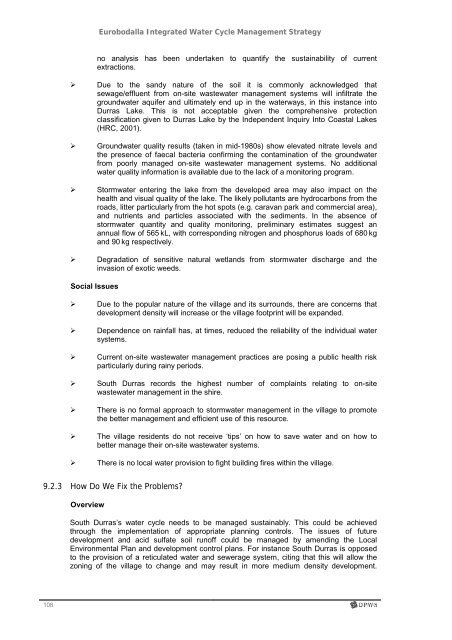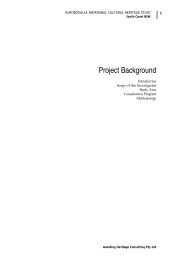Eurobodalla Integrated Water Cycle Management Strategy
Eurobodalla Integrated Water Cycle Management Strategy
Eurobodalla Integrated Water Cycle Management Strategy
You also want an ePaper? Increase the reach of your titles
YUMPU automatically turns print PDFs into web optimized ePapers that Google loves.
108<br />
<strong>Eurobodalla</strong> <strong>Integrated</strong> <strong>Water</strong> <strong>Cycle</strong> <strong>Management</strong> <strong>Strategy</strong><br />
no analysis has been undertaken to quantify the sustainability of current<br />
extractions.<br />
Due to the sandy nature of the soil it is commonly acknowledged that<br />
sewage/effluent from on-site wastewater management systems will infiltrate the<br />
groundwater aquifer and ultimately end up in the waterways, in this instance into<br />
Durras Lake. This is not acceptable given the comprehensive protection<br />
classification given to Durras Lake by the Independent Inquiry Into Coastal Lakes<br />
(HRC, 2001).<br />
Groundwater quality results (taken in mid-1980s) show elevated nitrate levels and<br />
the presence of faecal bacteria confirming the contamination of the groundwater<br />
from poorly managed on-site wastewater management systems. No additional<br />
water quality information is available due to the lack of a monitoring program.<br />
Stormwater entering the lake from the developed area may also impact on the<br />
health and visual quality of the lake. The likely pollutants are hydrocarbons from the<br />
roads, litter particularly from the hot spots (e.g. caravan park and commercial area),<br />
and nutrients and particles associated with the sediments. In the absence of<br />
stormwater quantity and quality monitoring, preliminary estimates suggest an<br />
annual flow of 565 kL, with corresponding nitrogen and phosphorus loads of 680 kg<br />
and 90 kg respectively.<br />
Degradation of sensitive natural wetlands from stormwater discharge and the<br />
invasion of exotic weeds.<br />
Social Issues<br />
Due to the popular nature of the village and its surrounds, there are concerns that<br />
development density will increase or the village footprint will be expanded.<br />
Dependence on rainfall has, at times, reduced the reliability of the individual water<br />
systems.<br />
Current on-site wastewater management practices are posing a public health risk<br />
particularly during rainy periods.<br />
South Durras records the highest number of complaints relating to on-site<br />
wastewater management in the shire.<br />
There is no formal approach to stormwater management in the village to promote<br />
the better management and efficient use of this resource.<br />
The village residents do not receive ‘tips’ on how to save water and on how to<br />
better manage their on-site wastewater systems.<br />
There is no local water provision to fight building fires within the village.<br />
9.2.3 How Do We Fix the Problems?<br />
Overview<br />
South Durras’s water cycle needs to be managed sustainably. This could be achieved<br />
through the implementation of appropriate planning controls. The issues of future<br />
development and acid sulfate soil runoff could be managed by amending the Local<br />
Environmental Plan and development control plans. For instance South Durras is opposed<br />
to the provision of a reticulated water and sewerage system, citing that this will allow the<br />
zoning of the village to change and may result in more medium density development.

















